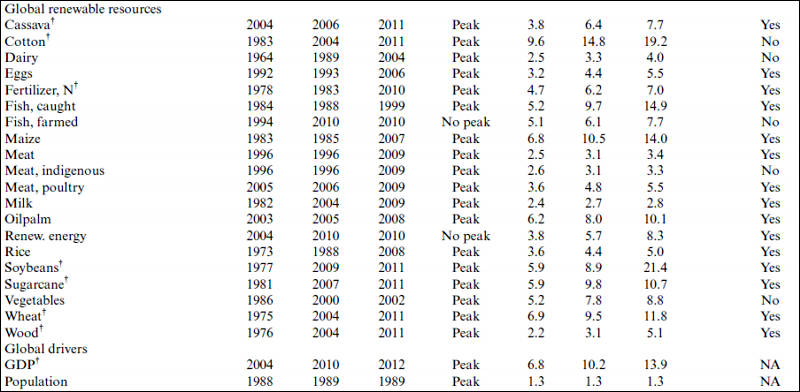
-
Many separate studies have estimated the year of peak, or maximum, rate of using an individual resource such as oil. However, no study has estimated the year of peak rate for multiple resources and investigated the relationships among them. We exploit time series on the appropriation of 27 global renewable and nonrenewable resources. We found 21 resources experienced a peak-rate year, and for 20 resources the peak-rate years occurred between 1960-2010, a narrow time window in the long human history. Whereas 4 of 7 nonrenewable resources show no peak-rate year, conversion to cropland and 18 of the 20 renewable resources have passed their peak rate of appropriation. To test the hypothesis that peak-rate years are synchronized, i.e., occur at approximately the same time, we analyzed 20 statistically independent time series of resources, of which 16 presented a peak-rate year centered on 2006 (1989-2008). We discuss potential causal mechanisms including change in demand, innovation and adaptation, interdependent use of resources, physical limitation, and simultaneous scarcity. The synchrony of peak-rate years of multiple resources poses a greater adaptation challenge for society than previously recognized, suggesting the need for a paradigm shift in resource use toward a sustainable path in the Anthropocene.

-
Such an interesting study. Thanks for posting this. I'm still reading, but in my first go-through, it seems that their definition of peak-rate (the year of maximum growth) is different from the definition we'd use for something like "peak oil" where it would be the year of maximum production.
Howdy, Stranger!
It looks like you're new here. If you want to get involved, click one of these buttons!
Categories
- Topics List23,990
- Blog5,725
- General and News1,353
- Hacks and Patches1,153
- ↳ Top Settings33
- ↳ Beginners256
- ↳ Archives402
- ↳ Hacks News and Development56
- Cameras2,367
- ↳ Panasonic995
- ↳ Canon118
- ↳ Sony156
- ↳ Nikon96
- ↳ Pentax and Samsung70
- ↳ Olympus and Fujifilm101
- ↳ Compacts and Camcorders300
- ↳ Smartphones for video97
- ↳ Pro Video Cameras191
- ↳ BlackMagic and other raw cameras116
- Skill1,960
- ↳ Business and distribution66
- ↳ Preparation, scripts and legal38
- ↳ Art149
- ↳ Import, Convert, Exporting291
- ↳ Editors191
- ↳ Effects and stunts115
- ↳ Color grading197
- ↳ Sound and Music280
- ↳ Lighting96
- ↳ Software and storage tips266
- Gear5,420
- ↳ Filters, Adapters, Matte boxes344
- ↳ Lenses1,582
- ↳ Follow focus and gears93
- ↳ Sound499
- ↳ Lighting gear314
- ↳ Camera movement230
- ↳ Gimbals and copters302
- ↳ Rigs and related stuff273
- ↳ Power solutions83
- ↳ Monitors and viewfinders340
- ↳ Tripods and fluid heads139
- ↳ Storage286
- ↳ Computers and studio gear560
- ↳ VR and 3D248
- Showcase1,859
- Marketplace2,834
- Offtopic1,319




